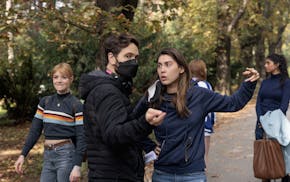Hmong Academy in St. Paul graduated its second class last week. Just about every senior at the charter school walked across the stage, smiled and grabbed a diploma.
In fact, the school's graduation rate is 94 percent. What's the big deal about that? Well, for starters, 99 percent of Hmong Academy's 450 students live in poverty, 99 percent are from minority groups and 83 percent are learning how to speak, read and write English -- groups that often struggle in high school.
They're doing just fine at Hmong Academy, where community leaders and educators have forged a school founded to reinforce Hmong values and culture while at the same time girding students to succeed in the western world. Christianna Hang, the school's director and chief financial officer, said Hmong Academy was started to stop kids from slipping through the cracks of the school system while strengthening their identities and obligations as Hmong-Americans.
"We wanted back-to-the-basics: Respect your elders. What should you do if you want to be a leader? How to care for your community. And how to commit to your culture," said Hang, who worked for years in the Minneapolis Public Schools and at Seed Academy charter school in Minneapolis. "We wanted a school that addresses how do you become a Hmong-American in this society."
Back to the basics does not mean basic education, Hang said. It means focusing on core values and strong families. "Our culture is based on leadership, community service and caring about more than yourself," she said.
And the curriculum itself is far from basic. Of the school's 40 graduates last year, 35 are enrolled in college and five joined the military, Hang said. This year, the school graduated nearly 90 students; almost all have applied to multiple colleges and universities.
This fall, the school will organize itself into four universities -- each with a program focus, such as fine arts and humanities or math, technology, science and medicine -- and each university will offer a variety of courses and subjects, all designed to get students thinking about college and careers as early as ninth grade.
Each month of the school year will focus on one of the three C's, Hang said: caring, college and careers. By the time they are seniors, students will have visited colleges, worked at internships, job-shadowed, taken the PSAT, SAT and ACT college entrance exams, and applied to multiple colleges or vocational schools, she said.
Students feel at home
Steven Wang, 17, started at Hmong Academy as a ninth-grader four years ago. He's starts at Hamline University in the fall.
"It's really unbelievable," he said of graduating last week. "You never expect this day to come, not so soon."
He remembers his first day at the school. "It was heartwarming. You could see all the teachers with a big smile on their faces. As the first week went by, they already knew your name."
Wang took advantage of Advanced Placement classes and College in the Schools classes to get a head start on college. Higher education was never in doubt, he said. "That's expected."
All of this works, Hang said, because the school is big enough to offer opportunities and small enough to provide personal attention. Every staff member works as a mentor and adviser to the same 15 to 18 students over four years of high school. The school started with 200 students in ninth and 10th grades in 2004. It will have 600 to 700 students in kindergarten through 12th grade by 2010, Hang said.
Danijela Duvnjak has been a Hmong Academy teacher since the school's inception. "The kids here are able to connect with their culture and feel cared for," she said the day before graduation last week. "Tomorrow's really going to be a tough moment for me. They are my kids."
The curriculum is demanding, said teacher Sonya Klimek, who focuses on technology. But the school's small, personal environment makes students comfortable.
"I know what that feels like," she said. "I am the product of a small liberal arts college where I knew my professor's name."
Her kids don't only know Duvnjak's name, they have her cell phone number -- and they call often with questions about assignments, or whatever.
Kids who slip through cracks
Hang said her background convinced her that Hmong Academy was needed. She was born in Laos and her family later moved to a refugee camp in Thailand. Later, after her brother came to the United States, her family followed to Hawaii, then Minnesota. She graduated from South High School in Minneapolis and then Concordia University-St. Paul. Along the way, though, Hang said she never felt that educators took much of a personal interest in her or her future.
As a teacher and administrator in Minneapolis, she said, she saw many minority kids slipping through the cracks -- especially in middle school and high school. And four years working for Seed Academy, a charter school with a focus on African-American culture and community, convinced her that a similar approach would work for Hmong students.
"I always told myself that I wanted to do something for the bigger community," Hang said. "That is Hmong Academy."
James Walsh • 651-298-1541
Rollover wreck of vehicle exiting I-94 in Minneapolis leaves 1 woman dead, 4 injured

Perfection comes with a reward for 3 teams in baseball Metro Top 10

Shakopee Mdewakanton tribe applies to put 815 acres in southwest metro into trust

Lakeville teachers vote to authorize strike
